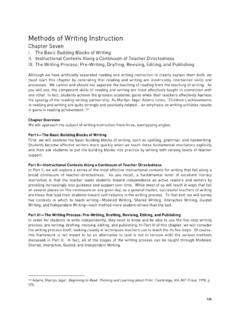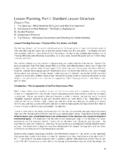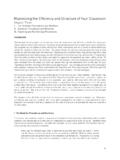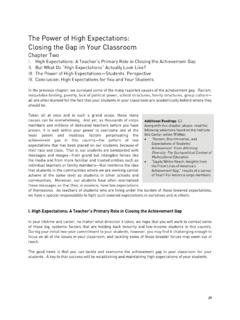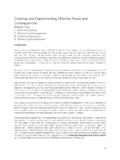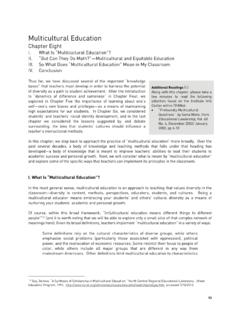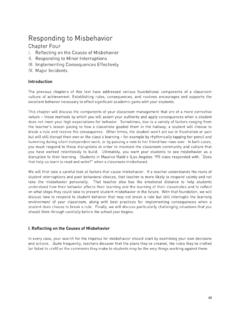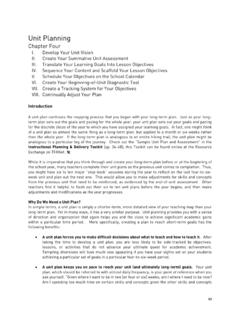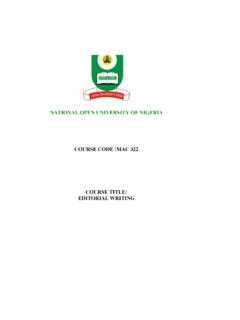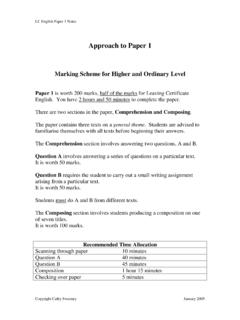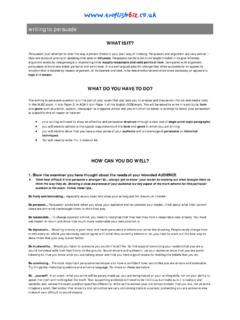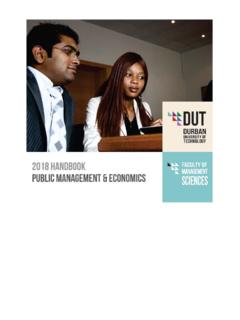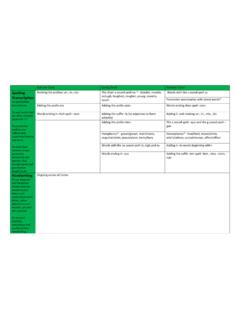Transcription of Structuring Your Literacy Classroom: A Balanced Literacy ...
1 Structuring your Literacy classroom : A Balanced Literacy Block (K to 5). Chapter Eight I. Read Aloud II. Shared Reading III. Guided Reading IV. Independent Reading V. Word Study VI. Writing The previous chapters of this text examined each component of Balanced Literacy instruction in depth. This chapter is intended to bring all of those components together, providing you with a context for understanding how to structure your Literacy classroom so that each instructional moment propels your students forward as readers and writers. All that we have learned about Literacy instruction from the grade level standards and assessment tools discussed in chapter two to the research-based instructional methods explored in chapters four through seven culminates in a real classroom with real students.
2 Our hope is that you will be able to synthesize all that you have learned in this text as you prepare to become an exemplary Literacy teacher. To that end, this chapter is about the implementation of effective, research-based strategies and activities during the instructional day. In districts across the country, teachers are weaving instruction in each component of Literacy throughout an uninterrupted block of time the Balanced Literacy block. Though the time allotted for the block and its components varies by grade-level, school, and district, it is common for elementary teachers to devote two to three hours each day to Literacy instruction.
3 The individual parts of the Balanced Literacy block include: Read Aloud Shared Reading Guided Reading Independent Reading Word Study Writing Every day throughout the year, teachers read to students during the Read Aloud, read with students during Shared Reading and Guided Reading, and listen to and assess students' reading during Independent Reading. During the Word Study portion of the Balanced Literacy block, teachers provide explicit and systematic instruction in the building blocks of Literacy book and print awareness, phonological and phonemic awareness, phonics and the alphabetic principle, and word and structural analysis.
4 Finally, teachers plan their writing instruction so that they model excellent writing for students, share the pen with students during Shared and Interactive Writing, and conference with students as they write independently. Most likely, your school or district will provide guidance on how to structure your Literacy block. Consider two schedules that an exemplary second grade and fourth grade teacher follow to ensure that their students receive instruction and practice in all the components of Literacy . 141. A Balanced Literacy Block Ms. Cleary's Second Grade Literacy Block Mr.
5 Moreno's Fourth Grade Literacy Block 8:20-8:30 Morning Meeting 8:20-8:30 Do Now and Community Meetings Brief shared writing activity; student of the Do Now (correcting sentences for grammar, day shares the news, teacher scripts language mechanics, and spelling). message Daily goal setting/problem solving Daily goal setting and class pledge 8:30-8:55 Read Aloud 8:30-8:55 Read Aloud Students will improve reading comprehension Read chapter of The Watsons Go To Birmingham by by making inferences about characters in Christopher Paul Curtis; continue to model using a Julius, Baby of the World by Kevin Henkes two-column journal entry to record a short passage of text on the left, and the thoughts or questions that the passage sparked on the right 8:55-9:35 Shared Reading 8:55-9:45 Shared Reading Students will improve reading comprehension Preview vocabulary (through word web) in next by making predictions about The Tortoise and chapter of The Gold Cadillac by Mildred Taylor.
6 The Hare whole class discussion of what has happened so Students will build fluency through echo far in the novel, think-pair-share predictions (with reading explanations) for upcoming chapter Read next chapter (teacher reads first page aloud while students track; students read next two pages with a partner and then finish the chapter independently). Remind students to discuss the passage with their partner and use their two-column journal entry to record thoughts and questions After reading, place one passage on the overhead and lead class discussion on what thoughts or questions it sparked; students journal to record ideas 9:35-10:05 Guided Reading/ Literacy Centers 9:45-10:15 Guided Reading/Independent Reading Small group differentiated instruction.
7 Meet with two groups, one to receive additional Octavia, Joshua, Barry, Tia will be able to instruction in long vowel spelling patterns, the summarize portions of a book (summary other to build fluency through a phrasing lesson sentences on sticky notes) Other students reading independent leveled books Other students working independently at the and responding in a two-column journal entry as listening center (students with fluency needs), needed (Clayton, Shawnice and Troy read along word sorting center (students who need more with independent-level book on tape to work on practice with vowel consonant e pattern), fluency).
8 Word work center (students quiz each other on word wall words/decodable words and read decodable books), reading response center (students from previous day's guided reading group work to reread the book and write in their journals about it), and buddy reading (students doing repeated reading to build fluency). 10:05-10:25 Independent Reading 10:15-10:40 Word Study Student read books on their independent Target morphemic patterns: -tion, -tient, -tience reading level Blending, sorting, and dictation activities Conferences/assessments with Nikya, Daquaz, and Juan 142.
9 Ms. Cleary's Second Grade Literacy Block Mr. Moreno's Fourth Grade Literacy Block 10:25-10:55 Word Study 11:40-11:40 Writer's Workshop Target spelling pattern: the / / sound spelled Students work to revise their memoirs by adding ai_ and _ay supporting details to demonstrate their courage, Blending, sorting, and dictation activities pride, or persistence. Discuss what details Lois Lowry gave us to identify character traits in her characters 11:00-11:30 Lunch 11:40-12:10 Lunch 11:30-12:10 Writer's Workshop Begin persuasive unit: pre-writing by reading A Fine, Fine School and discussing the genre of persuasion; students describe the purpose of persuasion in notebooks As you can see, both the second and fourth grade Literacy blocks are broken into similar parts (Read Aloud, Shared Reading, etc.)
10 , but the time allotted for decoding and comprehension differs. While second graders in Ms. Cleary's classroom spend a half hour in Word Study, Mr. Moreno's fourth graders devote slightly less time to that part of the block. Further, Mr. Moreno's students devote significantly more time over the course of the morning to comprehension activities. Another difference between these two classrooms is the emphasis given to certain Literacy skills. A quick glance at their schedules tells us that both teachers use a research-based scope and sequence. While Ms.
